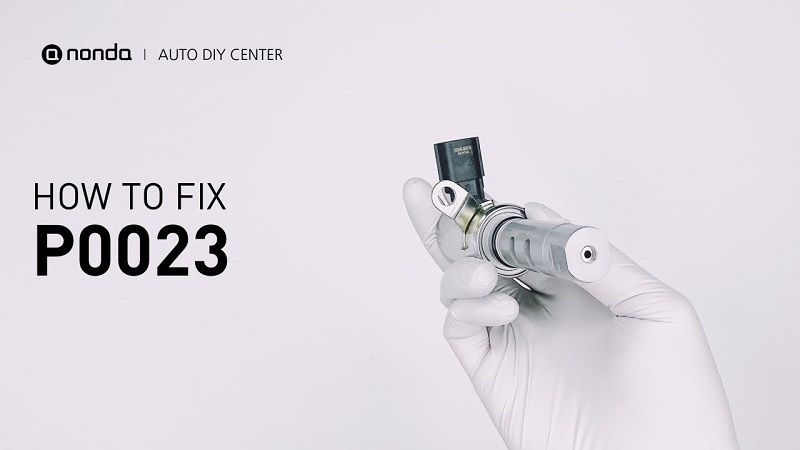This post contains affiliate links. This means I will make a commission at no extra cost to you should you click through and make a purchase [ “As an Amazon Associate, I earn from qualifying purchases.” ]. Read the full disclosure here.
Deciphering the P0023 Code: “B” Camshaft Position – Actuator Circuit (Bank 2) GuideMechanic.Com In the realm of automotive diagnostics, error codes serve as crucial indicators of underlying issues within a vehicle’s intricate systems.
Among the myriad of diagnostic trouble codes (DTCs) encountered by car owners, the P0023 code is notable, indicating a fault related to the “B” Camshaft Position – Actuator Circuit on Bank 2.
In this comprehensive article, we’ll delve into the nuances of the P0023 code, elucidating its meaning, potential causes, symptoms, and steps for resolution.
See Also: P0021 Code “A” Camshaft Position – Timing Over-Advanced or System Performance (Bank 2)
Understanding the P0023 Code:

The P0023 code is a generic OBD-II trouble code that denotes a problem with the “B” Camshaft Position – Actuator Circuit on Bank 2 of the engine.
Simply put, it indicates an issue with the electrical circuitry or components responsible for controlling the timing of the camshaft on Bank 2 (usually the bank of cylinders opposite to Bank 1 in a V-type engine). This code is crucial for maintaining proper engine performance, fuel efficiency, and emissions.
Function of the “B” Camshaft Position:
Before delving into the potential causes of the P0023 code, it’s essential to understand the role of the “B” Camshaft Position. The camshaft position refers to the rotational position of the camshaft in relation to the crankshaft.
The Engine Control Module (ECM) or Powertrain Control Module (PCM) utilizes data from sensors to precisely control the timing of the camshaft, ensuring optimal engine operation.
Potential Causes of the P0023 Code:
Several factors can trigger the P0023 code, ranging from electrical faults to mechanical issues. Understanding these potential causes is pivotal for accurate diagnosis and resolution:
Faulty Camshaft Position Actuator:
A prevalent cause of the P0023 code is a malfunctioning camshaft position actuator. This component, controlled by the ECM or PCM, adjusts camshaft timing by regulating oil flow through the camshaft phasers. A defective actuator can disrupt timing on Bank 2, triggering the P0023 code.
Wiring or Connector Faults:
Electrical issues within the camshaft position actuator circuit, such as damaged wiring, corroded connectors, or poor electrical connections, can disrupt communication between the ECM or PCM and the actuator. This can lead to timing irregularities and trigger the P0023 code.
Camshaft Phaser Issues:

The camshaft phasers, responsible for altering camshaft timing, may experience mechanical problems such as wear, binding, or internal damage.
If the phasers on Bank 2 fail to respond correctly to ECM or PCM commands, it can result in timing irregularities and the setting of the P0023 code.
Oil Flow Restrictions:
Any restrictions or blockages in the oil passages supplying the camshaft phasers can affect their ability to adjust timing properly.
This may be caused by sludge buildup, debris, or improper oil viscosity. Insufficient oil flow can lead to timing irregularities and trigger the P0023 code.
Symptoms of the P0023 Code:
Vehicles experiencing the P0023 code may exhibit various symptoms, indicating timing irregularities on Bank 2. These symptoms may include:
Check Engine Light (CEL) Illumination:
The primary indication of the P0023 code is the illumination of the check engine light on the vehicle’s dashboard. The CEL serves as a warning to the driver that a fault has been detected within the engine management system.
Engine Performance Issues:
Timing irregularities can result in poor acceleration, reduced power output, or hesitation during acceleration. The engine may feel sluggish or unresponsive, especially under load or at higher speeds.
Rough Idle:

Vehicles affected by the P0023 code may experience rough or erratic idling. The engine may exhibit vibrations, fluctuations in idle speed, or a noticeable lack of smoothness.
Decreased Fuel Efficiency:
Timing irregularities can adversely affect fuel combustion efficiency, leading to decreased fuel economy. Drivers may notice increased fuel consumption over time, accompanied by frequent trips to the gas station.
Diagnosis and Resolution of the P0023 Code:
Resolving the P0023 code typically involves a systematic approach to diagnosis and repair. Here are the steps commonly taken by technicians:
Diagnostic Scan:
Using a compatible OBD-II scanner, technicians retrieve the P0023 code and any accompanying codes stored in the vehicle’s ECM or PCM. This provides valuable information about the nature of the fault and helps narrow down potential causes.
Visual Inspection:
A thorough visual inspection of the camshaft position actuator, wiring harness, connectors, and related components is conducted to identify any signs of damage, corrosion, or disconnection. Any issues found are addressed promptly.
Functional Testing:
Technicians perform functional tests to assess the operation of the camshaft position actuator and related components. This may involve checking for proper actuator movement, verifying oil pressure, and testing electrical signals using a multimeter.
Oil System Inspection:
The vehicle’s oil system is inspected for any signs of contamination, blockages, or low oil levels. Technicians may also check for proper oil viscosity and perform an oil pressure test to ensure sufficient lubrication to the camshaft phasers.
Component Replacement:
Based on the findings of diagnostic tests, faulty components such as the camshaft position actuator, camshaft phasers, or related parts are repaired or replaced as necessary.
Clearing Codes and Test Driving:
Once repairs are completed, technicians clear any stored fault codes from the vehicle’s ECM or PCM and conduct a test drive to verify that the issue has been resolved. If the repairs are successful, the check engine light should remain off, indicating that the problem has been addressed.
P0023 Code “B” Camshaft Position – Actuator Circuit (Bank 2)
Conclusion:
See Also: P0022 Code “A” Camshaft Position – Timing Over-Retarded (Bank 2)
The code, indicating “B” Camshaft Position – Actuator Circuit (Bank 2), is a common issue encountered by vehicle owners.
By understanding the potential causes, symptoms, and diagnostic steps associated with this code, technicians can efficiently diagnose and resolve timing irregularities, restoring engine performance and reliability.
Timely intervention and proper maintenance are essential for preventing the recurrence of the P0023 code and ensuring the continued health of the vehicle’s engine.
- P0000 Through P0099: Understanding OBD-II Trouble Codes - February 11, 2025
- P0000 Through P0199: Understanding OBD-II Trouble Codes - February 10, 2025
- P0080 Exhaust Valve Control Solenoid Circuit High (Bank 1) - February 9, 2025
